
Question Number 15570 by tawa tawa last updated on 11/Jun/17
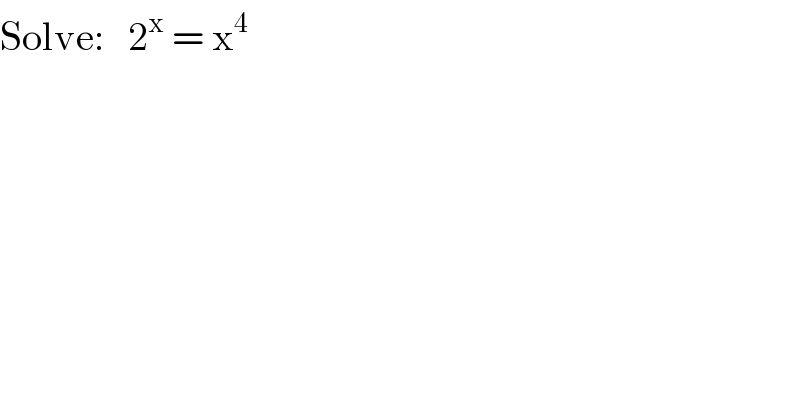
$$\mathrm{Solve}:\:\:\:\mathrm{2}^{\mathrm{x}} \:=\:\mathrm{x}^{\mathrm{4}} \\ $$
Commented by tawa tawa last updated on 11/Jun/17

$$\mathrm{workings} \\ $$
Answered by b.e.h.i.8.3.4.1.7@gmail.com last updated on 12/Jun/17
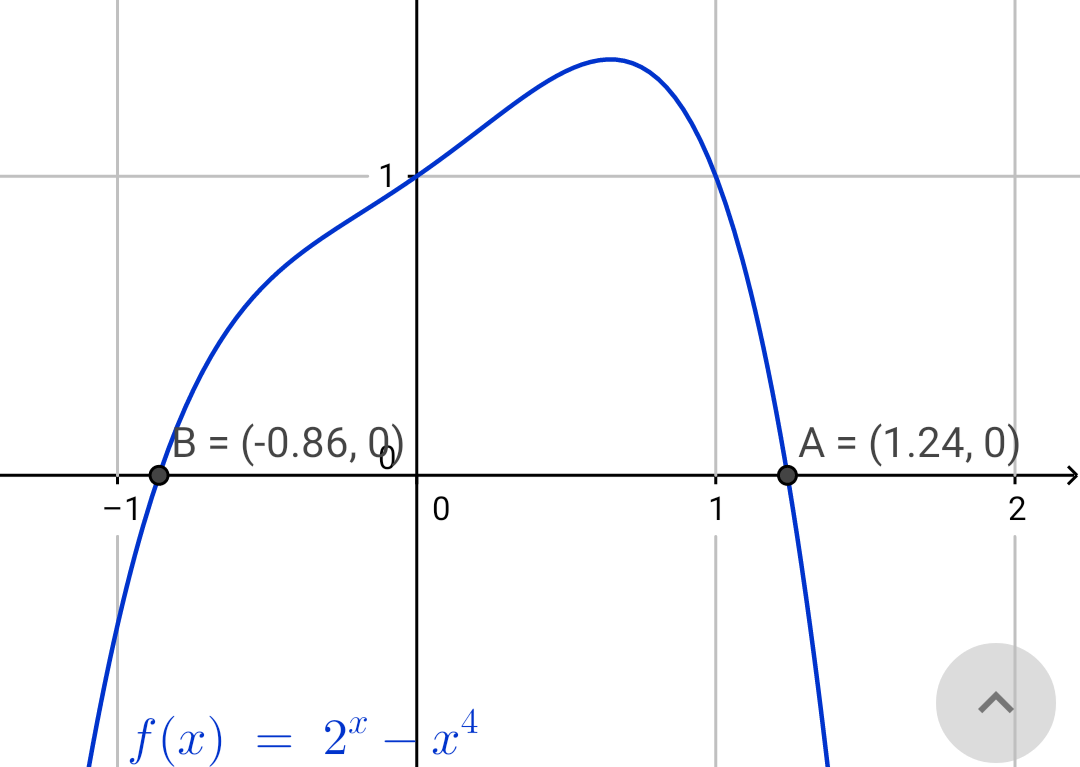
Commented by mrW1 last updated on 12/Jun/17

$$\mathrm{the}\:\mathrm{graph}\:\mathrm{is}\:\mathrm{much}\:\mathrm{bigger}\:\mathrm{than}\:\mathrm{what} \\ $$$$\mathrm{you}\:\mathrm{display}.\:\mathrm{there}\:\mathrm{is}\:\mathrm{a}\:\mathrm{third}\:\mathrm{zero} \\ $$$$\mathrm{point}\:\mathrm{on}\:\mathrm{the}\:\mathrm{right}\:\mathrm{side}. \\ $$
Commented by tawa tawa last updated on 12/Jun/17

$$\mathrm{God}\:\mathrm{bless}\:\mathrm{you}\:\mathrm{sir}. \\ $$$$ \\ $$
Answered by mrW1 last updated on 12/Jun/17
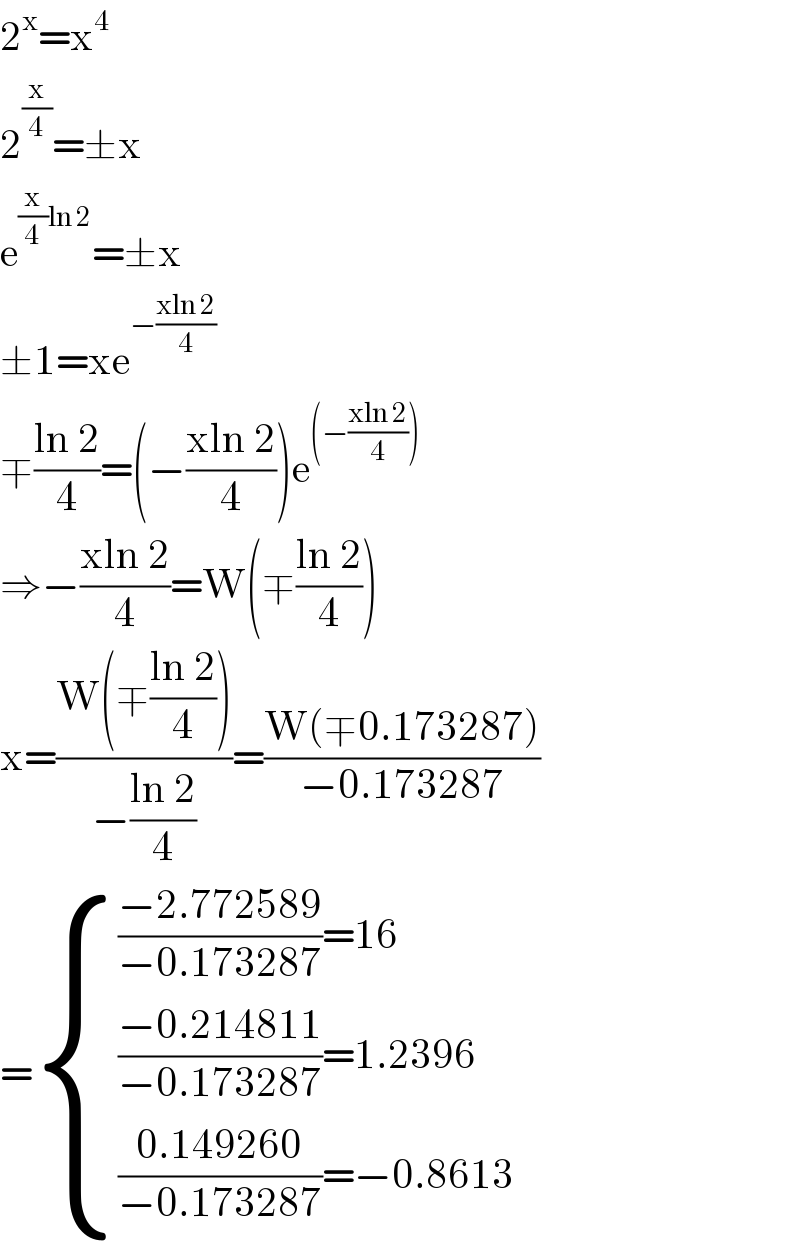
$$\mathrm{2}^{\mathrm{x}} =\mathrm{x}^{\mathrm{4}} \\ $$$$\mathrm{2}^{\frac{\mathrm{x}}{\mathrm{4}}} =\pm\mathrm{x} \\ $$$$\mathrm{e}^{\frac{\mathrm{x}}{\mathrm{4}}\mathrm{ln}\:\mathrm{2}} =\pm\mathrm{x} \\ $$$$\pm\mathrm{1}=\mathrm{xe}^{−\frac{\mathrm{xln}\:\mathrm{2}}{\mathrm{4}}} \\ $$$$\mp\frac{\mathrm{ln}\:\mathrm{2}}{\mathrm{4}}=\left(−\frac{\mathrm{xln}\:\mathrm{2}}{\mathrm{4}}\right)\mathrm{e}^{\left(−\frac{\mathrm{xln}\:\mathrm{2}}{\mathrm{4}}\right)} \\ $$$$\Rightarrow−\frac{\mathrm{xln}\:\mathrm{2}}{\mathrm{4}}=\mathrm{W}\left(\mp\frac{\mathrm{ln}\:\mathrm{2}}{\mathrm{4}}\right) \\ $$$$\mathrm{x}=\frac{\mathrm{W}\left(\mp\frac{\mathrm{ln}\:\mathrm{2}}{\mathrm{4}}\right)}{−\frac{\mathrm{ln}\:\mathrm{2}}{\mathrm{4}}}=\frac{\mathrm{W}\left(\mp\mathrm{0}.\mathrm{173287}\right)}{−\mathrm{0}.\mathrm{173287}} \\ $$$$=\begin{cases}{\frac{−\mathrm{2}.\mathrm{772589}}{−\mathrm{0}.\mathrm{173287}}=\mathrm{16}}\\{\frac{−\mathrm{0}.\mathrm{214811}}{−\mathrm{0}.\mathrm{173287}}=\mathrm{1}.\mathrm{2396}}\\{\frac{\mathrm{0}.\mathrm{149260}}{−\mathrm{0}.\mathrm{173287}}=−\mathrm{0}.\mathrm{8613}}\end{cases} \\ $$
Commented by tawa tawa last updated on 12/Jun/17

$$\mathrm{God}\:\mathrm{bless}\:\mathrm{you}\:\mathrm{sir}. \\ $$$$ \\ $$
Commented by Tinkutara last updated on 12/Jun/17

$$\mathrm{Sir},\:\mathrm{how}\:\mathrm{do}\:\mathrm{you}\:\mathrm{calculate}\:{W}\left(\pm\:\mathrm{0}.\mathrm{173287}\right)? \\ $$$$\mathrm{Is}\:\mathrm{there}\:\mathrm{any}\:\mathrm{method}\:\mathrm{to}\:\mathrm{calculate}\:\mathrm{this} \\ $$$$\mathrm{without}\:\mathrm{calculator}?\:\mathrm{How}\:\mathrm{to}\:\mathrm{find}\:\mathrm{this} \\ $$$$\mathrm{using}\:\mathrm{Geogebra}? \\ $$
Commented by mrW1 last updated on 12/Jun/17
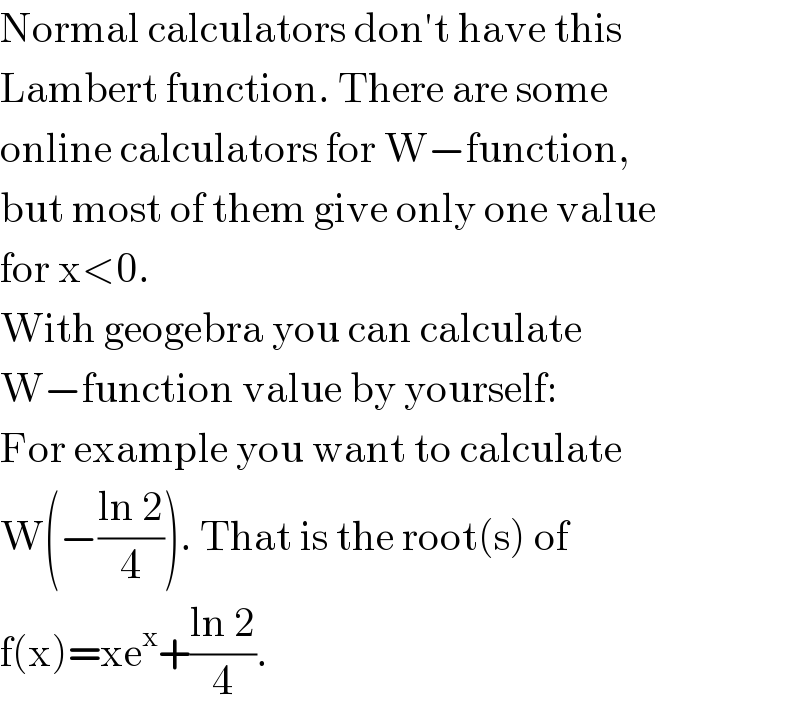
$$\mathrm{Normal}\:\mathrm{calculators}\:\mathrm{don}'\mathrm{t}\:\mathrm{have}\:\mathrm{this} \\ $$$$\mathrm{Lambert}\:\mathrm{function}.\:\mathrm{There}\:\mathrm{are}\:\mathrm{some} \\ $$$$\mathrm{online}\:\mathrm{calculators}\:\mathrm{for}\:\mathrm{W}−\mathrm{function}, \\ $$$$\mathrm{but}\:\mathrm{most}\:\mathrm{of}\:\mathrm{them}\:\mathrm{give}\:\mathrm{only}\:\mathrm{one}\:\mathrm{value} \\ $$$$\mathrm{for}\:\mathrm{x}<\mathrm{0}. \\ $$$$\mathrm{With}\:\mathrm{geogebra}\:\mathrm{you}\:\mathrm{can}\:\mathrm{calculate} \\ $$$$\mathrm{W}−\mathrm{function}\:\mathrm{value}\:\mathrm{by}\:\mathrm{yourself}: \\ $$$$\mathrm{For}\:\mathrm{example}\:\mathrm{you}\:\mathrm{want}\:\mathrm{to}\:\mathrm{calculate} \\ $$$$\mathrm{W}\left(−\frac{\mathrm{ln}\:\mathrm{2}}{\mathrm{4}}\right).\:\mathrm{That}\:\mathrm{is}\:\mathrm{the}\:\mathrm{root}\left(\mathrm{s}\right)\:\mathrm{of} \\ $$$$\mathrm{f}\left(\mathrm{x}\right)=\mathrm{xe}^{\mathrm{x}} +\frac{\mathrm{ln}\:\mathrm{2}}{\mathrm{4}}. \\ $$
Commented by mrW1 last updated on 12/Jun/17
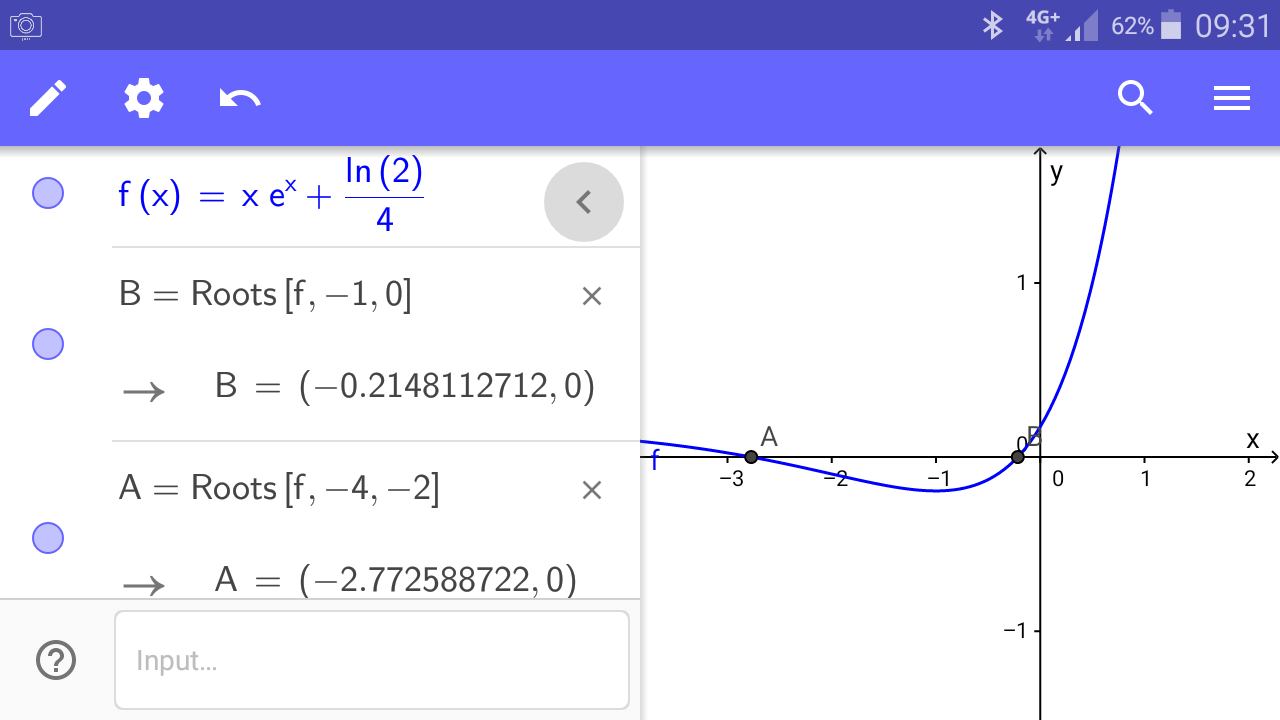
Commented by Tinkutara last updated on 12/Jun/17

$$\mathrm{Do}\:\mathrm{you}\:\mathrm{mean}\:\mathrm{that}\:\mathrm{in}\:\mathrm{general}\:\mathrm{if}\:\mathrm{we} \\ $$$$\mathrm{want}\:{W}\left({n}\right),\:\mathrm{these}\:\mathrm{are}\:\mathrm{the}\:\mathrm{roots}\:\mathrm{of} \\ $$$${f}\left({x}\right)\:=\:{xe}^{{x}} \:−\:{n}\:? \\ $$
Commented by mrW1 last updated on 12/Jun/17

$$\mathrm{yes}.\:\mathrm{this}\:\mathrm{is}\:\mathrm{the}\:\mathrm{definition}\:\mathrm{of}\:\mathrm{W}\:\mathrm{function}. \\ $$
Commented by Tinkutara last updated on 12/Jun/17

$$\mathrm{Thanks}\:\mathrm{Sir}! \\ $$
Commented by tawa tawa last updated on 12/Jun/17
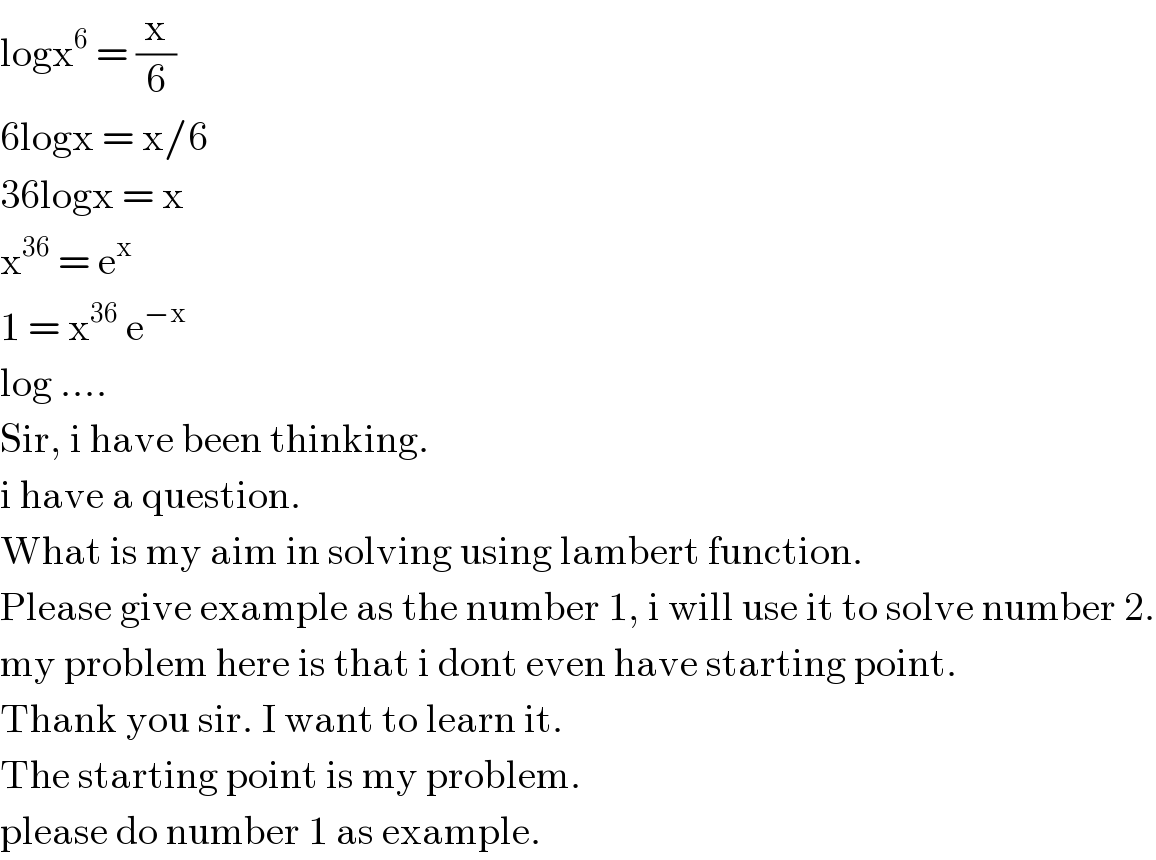
$$\mathrm{logx}^{\mathrm{6}} \:=\:\frac{\mathrm{x}}{\mathrm{6}} \\ $$$$\mathrm{6logx}\:=\:\mathrm{x}/\mathrm{6} \\ $$$$\mathrm{36logx}\:=\:\mathrm{x} \\ $$$$\mathrm{x}^{\mathrm{36}} \:=\:\mathrm{e}^{\mathrm{x}} \\ $$$$\mathrm{1}\:=\:\mathrm{x}^{\mathrm{36}} \:\mathrm{e}^{−\mathrm{x}} \\ $$$$\mathrm{log}\:.... \\ $$$$\mathrm{Sir},\:\mathrm{i}\:\mathrm{have}\:\mathrm{been}\:\mathrm{thinking}. \\ $$$$\mathrm{i}\:\mathrm{have}\:\mathrm{a}\:\mathrm{question}.\: \\ $$$$\mathrm{What}\:\mathrm{is}\:\mathrm{my}\:\mathrm{aim}\:\mathrm{in}\:\mathrm{solving}\:\mathrm{using}\:\mathrm{lambert}\:\mathrm{function}. \\ $$$$\mathrm{Please}\:\mathrm{give}\:\mathrm{example}\:\mathrm{as}\:\mathrm{the}\:\mathrm{number}\:\mathrm{1},\:\mathrm{i}\:\mathrm{will}\:\mathrm{use}\:\mathrm{it}\:\mathrm{to}\:\mathrm{solve}\:\mathrm{number}\:\mathrm{2}. \\ $$$$\mathrm{my}\:\mathrm{problem}\:\mathrm{here}\:\mathrm{is}\:\mathrm{that}\:\mathrm{i}\:\mathrm{dont}\:\mathrm{even}\:\mathrm{have}\:\mathrm{starting}\:\mathrm{point}. \\ $$$$\mathrm{Thank}\:\mathrm{you}\:\mathrm{sir}.\:\mathrm{I}\:\mathrm{want}\:\mathrm{to}\:\mathrm{learn}\:\mathrm{it}. \\ $$$$\mathrm{The}\:\mathrm{starting}\:\mathrm{point}\:\mathrm{is}\:\mathrm{my}\:\mathrm{problem}.\: \\ $$$$\mathrm{please}\:\mathrm{do}\:\mathrm{number}\:\mathrm{1}\:\mathrm{as}\:\mathrm{example}. \\ $$
Commented by tawa tawa last updated on 12/Jun/17

$$\mathrm{Please}\:\mathrm{give}\:\mathrm{me}\:\mathrm{one}\:\mathrm{question}\:\mathrm{on}\:\mathrm{this},\:\mathrm{let}\:\mathrm{me}\:\mathrm{solve}\:\mathrm{it}. \\ $$
Commented by mrW1 last updated on 12/Jun/17
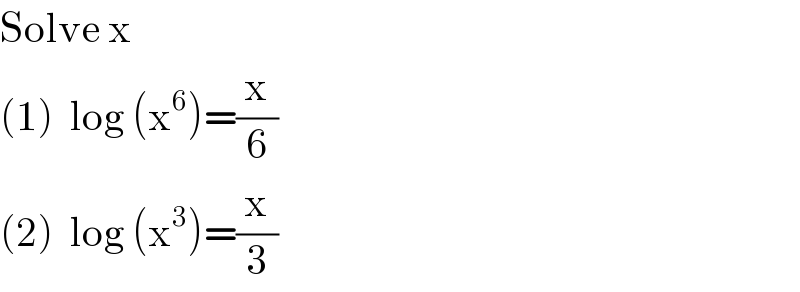
$$\mathrm{Solve}\:\mathrm{x} \\ $$$$\left(\mathrm{1}\right)\:\:\mathrm{log}\:\left(\mathrm{x}^{\mathrm{6}} \right)=\frac{\mathrm{x}}{\mathrm{6}} \\ $$$$\left(\mathrm{2}\right)\:\:\mathrm{log}\:\left(\mathrm{x}^{\mathrm{3}} \right)=\frac{\mathrm{x}}{\mathrm{3}} \\ $$
Commented by mrW1 last updated on 12/Jun/17

$$\mathrm{To}\:\mathrm{be}\:\mathrm{able}\:\mathrm{to}\:\mathrm{use}\:\mathrm{Lambert}\:\mathrm{function} \\ $$$$\mathrm{we}\:\mathrm{must}\:\mathrm{re}−\mathrm{arange}\:\mathrm{the}\:\mathrm{original} \\ $$$$\mathrm{equation}\:\mathrm{into}\:\mathrm{following}\:\mathrm{form}: \\ $$$$\mathrm{A}×\mathrm{e}^{\mathrm{A}} =\mathrm{B} \\ $$$$\mathrm{wherein}\:\mathrm{A}\:\mathrm{is}\:\mathrm{a}\:\mathrm{expression}\:\mathrm{with}\:\mathrm{x}\:\mathrm{and} \\ $$$$\mathrm{B}\:\mathrm{is}\:\mathrm{a}\:\mathrm{expression}\:\mathrm{with}\:\mathrm{constants}\:\mathrm{only}. \\ $$$$\mathrm{The}\:\mathrm{solution}\:\mathrm{is}\:\mathrm{then} \\ $$$$\mathrm{A}=\boldsymbol{\mathrm{W}}\left(\mathrm{B}\right) \\ $$$$\mathrm{Example}\:\mathrm{1}:\:\mathrm{log}\:\mathrm{x}^{\mathrm{6}} =\frac{\mathrm{x}}{\mathrm{6}} \\ $$$$\Rightarrow\mathrm{6log}\:\left(\pm\mathrm{x}\right)=\frac{\mathrm{x}}{\mathrm{6}}\:\:\:\:\:\:\:\:\:\:\left(\pm\:\mathrm{because}\:\mathrm{x}\:\mathrm{can}\:\mathrm{be}\:+\:\mathrm{or}\:−\right) \\ $$$$\mathrm{we}\:\mathrm{consider}\:+\mathrm{x}\:\mathrm{at}\:\mathrm{first} \\ $$$$\Rightarrow\mathrm{log}\:\left(\mathrm{x}\right)=\frac{\mathrm{x}}{\mathrm{36}} \\ $$$$\Rightarrow\frac{\mathrm{ln}\:\mathrm{x}}{\mathrm{ln}\:\mathrm{10}}=\frac{\mathrm{x}}{\mathrm{36}} \\ $$$$\Rightarrow\mathrm{ln}\:\mathrm{x}=\frac{\mathrm{ln}\:\mathrm{10}}{\mathrm{36}}\mathrm{x} \\ $$$$\Rightarrow\mathrm{x}=\mathrm{e}^{\frac{\mathrm{ln}\:\mathrm{10}\:\mathrm{x}}{\mathrm{36}}} \\ $$$$\Rightarrow\mathrm{xe}^{−\frac{\mathrm{ln}\:\mathrm{10}\:\mathrm{x}}{\mathrm{36}}} =\mathrm{1} \\ $$$$\Rightarrow\left(−\frac{\mathrm{ln}\:\mathrm{10}\:\mathrm{x}}{\mathrm{36}}\right)\mathrm{e}^{−\frac{\mathrm{ln}\:\mathrm{10}\:\mathrm{x}}{\mathrm{36}}\:} =−\frac{\mathrm{ln}\:\mathrm{10}}{\mathrm{36}} \\ $$$$\mathrm{this}\:\mathrm{is}\:\mathrm{the}\:\mathrm{form}\:\mathrm{A}×\mathrm{e}^{\mathrm{A}} =\mathrm{B}\:\mathrm{we}\:\mathrm{need}. \\ $$$$\mathrm{the}\:\mathrm{solution}\:\mathrm{is} \\ $$$$−\frac{\mathrm{ln}\:\mathrm{10}\:\mathrm{x}}{\mathrm{36}}=\boldsymbol{\mathrm{W}}\left(−\frac{\mathrm{ln}\:\mathrm{10}}{\mathrm{36}}\right) \\ $$$$\Rightarrow\mathrm{x}=−\frac{\mathrm{36}}{\mathrm{ln}\:\mathrm{10}}×\boldsymbol{\mathrm{W}}\left(−\frac{\mathrm{ln}\:\mathrm{10}}{\mathrm{36}}\right) \\ $$$$\mathrm{we}\:\mathrm{will}\:\mathrm{get}\:\mathrm{here}\:\mathrm{2}\:\mathrm{values}\:\mathrm{for}\:\mathrm{x},\:\mathrm{since} \\ $$$$\boldsymbol{\mathrm{W}}\left(−\frac{\mathrm{ln}\:\mathrm{10}}{\mathrm{36}}\right)\:\mathrm{has}\:\mathrm{2}\:\mathrm{values}. \\ $$$$ \\ $$$$\mathrm{similarly}\:\mathrm{for}\:\mathrm{the}\:\mathrm{case}\:−\mathrm{x}\:\mathrm{we}\:\mathrm{have} \\ $$$$\Rightarrow\mathrm{log}\:\left(−\mathrm{x}\right)=\frac{\mathrm{x}}{\mathrm{36}} \\ $$$$\Rightarrow\frac{\mathrm{ln}\:\left(−\mathrm{x}\right)}{\mathrm{ln}\:\mathrm{10}}=\frac{\mathrm{x}}{\mathrm{36}} \\ $$$$\Rightarrow\mathrm{ln}\:\left(−\mathrm{x}\right)=\frac{\mathrm{ln}\:\mathrm{10}}{\mathrm{36}}\mathrm{x} \\ $$$$\Rightarrow−\mathrm{x}=\mathrm{e}^{\frac{\mathrm{ln}\:\mathrm{10}\:\mathrm{x}}{\mathrm{36}}} \\ $$$$\Rightarrow−\mathrm{xe}^{−\frac{\mathrm{ln}\:\mathrm{10}\:\mathrm{x}}{\mathrm{36}}} =\mathrm{1} \\ $$$$\Rightarrow\left(−\frac{\mathrm{ln}\:\mathrm{10}\:\mathrm{x}}{\mathrm{36}}\right)\mathrm{e}^{−\frac{\mathrm{ln}\:\mathrm{10}\:\mathrm{x}}{\mathrm{36}}\:} =\frac{\mathrm{ln}\:\mathrm{10}}{\mathrm{36}} \\ $$$$\Rightarrow−\frac{\mathrm{ln}\:\mathrm{10}\:\mathrm{x}}{\mathrm{36}}=\boldsymbol{\mathrm{W}}\left(\frac{\mathrm{ln}\:\mathrm{10}}{\mathrm{36}}\right) \\ $$$$\Rightarrow\mathrm{x}=−\frac{\mathrm{36}}{\mathrm{ln}\:\mathrm{10}}×\boldsymbol{\mathrm{W}}\left(\frac{\mathrm{ln}\:\mathrm{10}}{\mathrm{36}}\right) \\ $$$$\mathrm{we}\:\mathrm{will}\:\mathrm{get}\:\mathrm{here}\:\mathrm{only}\:\mathrm{one}\:\mathrm{value}\:\mathrm{for}\:\mathrm{x}. \\ $$$$ \\ $$$$\mathrm{All}\:\mathrm{solutions}\:\mathrm{are}\:\mathrm{thus} \\ $$$$\mathrm{x}=\begin{cases}{−\frac{\mathrm{36}}{\mathrm{ln}\:\mathrm{10}}×\boldsymbol{\mathrm{W}}\left(−\frac{\mathrm{ln}\:\mathrm{10}}{\mathrm{36}}\right)\:\rightarrow\:\mathrm{2}\:\mathrm{values}}\\{−\frac{\mathrm{36}}{\mathrm{ln}\:\mathrm{10}}×\boldsymbol{\mathrm{W}}\left(\frac{\mathrm{ln}\:\mathrm{10}}{\mathrm{36}}\right)\:\rightarrow\:\mathrm{1}\:\mathrm{value}}\end{cases} \\ $$
Commented by Tinkutara last updated on 12/Jun/17
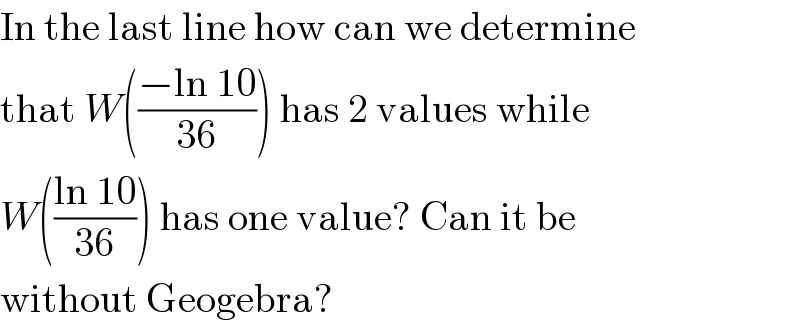
$$\mathrm{In}\:\mathrm{the}\:\mathrm{last}\:\mathrm{line}\:\mathrm{how}\:\mathrm{can}\:\mathrm{we}\:\mathrm{determine} \\ $$$$\mathrm{that}\:{W}\left(\frac{−\mathrm{ln}\:\mathrm{10}}{\mathrm{36}}\right)\:\mathrm{has}\:\mathrm{2}\:\mathrm{values}\:\mathrm{while} \\ $$$${W}\left(\frac{\mathrm{ln}\:\mathrm{10}}{\mathrm{36}}\right)\:\mathrm{has}\:\mathrm{one}\:\mathrm{value}?\:\mathrm{Can}\:\mathrm{it}\:\mathrm{be} \\ $$$$\mathrm{without}\:\mathrm{Geogebra}? \\ $$
Commented by mrW1 last updated on 12/Jun/17

$$\mathrm{W}\left(\mathrm{x}\right)\:\mathrm{is}\:\mathrm{the}\:\mathrm{inverse}\:\mathrm{function}\:\mathrm{of}\:\mathrm{f}\left(\mathrm{x}\right)=\mathrm{xe}^{\mathrm{x}} \\ $$$$\mathrm{W}\left(\mathrm{x}\right)\:\mathrm{has}\:\mathrm{only}\:\mathrm{one}\:\mathrm{value}\:\mathrm{if}\:\mathrm{x}\geqslant\mathrm{0} \\ $$$$\mathrm{and}\:\mathrm{2}\:\mathrm{values}\:\mathrm{if}\:−\frac{\mathrm{1}}{\mathrm{e}}<\mathrm{x}<\mathrm{0}. \\ $$
Commented by mrW1 last updated on 12/Jun/17
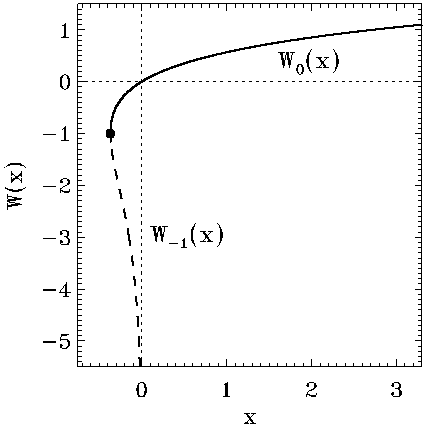
Commented by tawa tawa last updated on 12/Jun/17
![2) ln(x^3 ) = (x/3) 3ln(±x) = (x/3) ln(±x) = (x/9) ((ln(±x))/(ln(10))) = (x/9) ln(±x) = ((xln(10))/9) ± x = e^((xln(10))/9) 1 = ±xe^(−((xln(10))/9)) −((xln(10))/9)e^(−((xln(10))/9)) = −((ln10)/9) −((xln(10))/9) = W[−((ln(10))/9)] x = − (9/(ln(10))) W[−((ln(10))/9)] x = − ((9(−0.3706))/(ln(10))) or x = ((9(−2.110))/(ln(10)))](Q15658.png)
$$\left.\mathrm{2}\right) \\ $$$$\mathrm{ln}\left(\mathrm{x}^{\mathrm{3}} \right)\:=\:\frac{\mathrm{x}}{\mathrm{3}} \\ $$$$\mathrm{3ln}\left(\pm\mathrm{x}\right)\:=\:\frac{\mathrm{x}}{\mathrm{3}} \\ $$$$\mathrm{ln}\left(\pm\mathrm{x}\right)\:=\:\frac{\mathrm{x}}{\mathrm{9}} \\ $$$$\frac{\mathrm{ln}\left(\pm\mathrm{x}\right)}{\mathrm{ln}\left(\mathrm{10}\right)}\:=\:\frac{\mathrm{x}}{\mathrm{9}} \\ $$$$\mathrm{ln}\left(\pm\mathrm{x}\right)\:=\:\frac{\mathrm{xln}\left(\mathrm{10}\right)}{\mathrm{9}} \\ $$$$\pm\:\mathrm{x}\:=\:\mathrm{e}^{\frac{\mathrm{xln}\left(\mathrm{10}\right)}{\mathrm{9}}} \\ $$$$\mathrm{1}\:=\:\pm\mathrm{xe}^{−\frac{\mathrm{xln}\left(\mathrm{10}\right)}{\mathrm{9}}} \\ $$$$−\frac{\mathrm{xln}\left(\mathrm{10}\right)}{\mathrm{9}}\mathrm{e}^{−\frac{\mathrm{xln}\left(\mathrm{10}\right)}{\mathrm{9}}} \:=\:−\frac{\mathrm{ln10}}{\mathrm{9}} \\ $$$$\:−\frac{\mathrm{xln}\left(\mathrm{10}\right)}{\mathrm{9}}\:=\:\mathrm{W}\left[−\frac{\mathrm{ln}\left(\mathrm{10}\right)}{\mathrm{9}}\right] \\ $$$$\:\mathrm{x}\:\:=\:−\:\frac{\mathrm{9}}{\mathrm{ln}\left(\mathrm{10}\right)}\:\mathrm{W}\left[−\frac{\mathrm{ln}\left(\mathrm{10}\right)}{\mathrm{9}}\right] \\ $$$$\mathrm{x}\:=\:\:−\:\frac{\mathrm{9}\left(−\mathrm{0}.\mathrm{3706}\right)}{\mathrm{ln}\left(\mathrm{10}\right)}\:\mathrm{or}\:\mathrm{x}\:=\:\:\frac{\mathrm{9}\left(−\mathrm{2}.\mathrm{110}\right)}{\mathrm{ln}\left(\mathrm{10}\right)}\: \\ $$
Commented by tawa tawa last updated on 12/Jun/17

$$\mathrm{God}\:\mathrm{bless}\:\mathrm{you}\:\mathrm{sir}. \\ $$
Commented by mrW1 last updated on 12/Jun/17
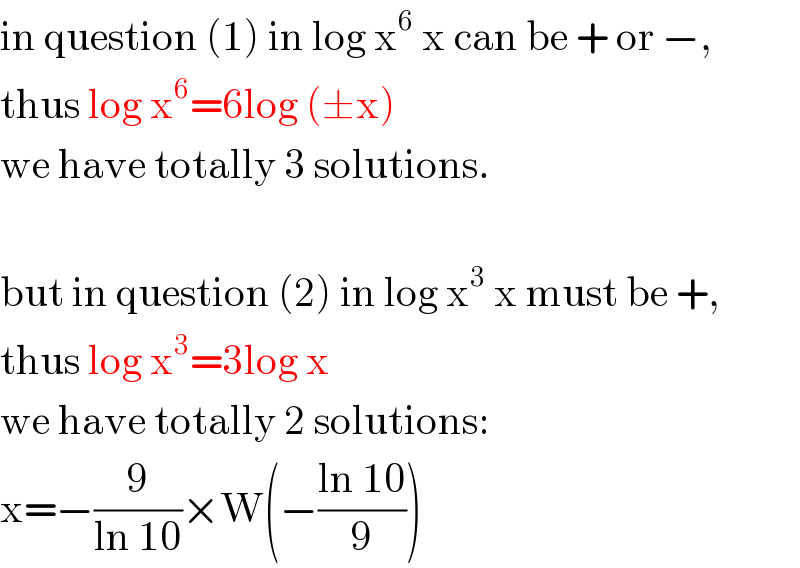
$$\mathrm{in}\:\mathrm{question}\:\left(\mathrm{1}\right)\:\mathrm{in}\:\mathrm{log}\:\mathrm{x}^{\mathrm{6}} \:\mathrm{x}\:\mathrm{can}\:\mathrm{be}\:+\:\mathrm{or}\:−, \\ $$$$\mathrm{thus}\:\mathrm{log}\:\mathrm{x}^{\mathrm{6}} =\mathrm{6log}\:\left(\pm\mathrm{x}\right) \\ $$$$\mathrm{we}\:\mathrm{have}\:\mathrm{totally}\:\mathrm{3}\:\mathrm{solutions}. \\ $$$$ \\ $$$$\mathrm{but}\:\mathrm{in}\:\mathrm{question}\:\left(\mathrm{2}\right)\:\mathrm{in}\:\mathrm{log}\:\mathrm{x}^{\mathrm{3}} \:\mathrm{x}\:\mathrm{must}\:\mathrm{be}\:+, \\ $$$$\mathrm{thus}\:\mathrm{log}\:\mathrm{x}^{\mathrm{3}} =\mathrm{3log}\:\mathrm{x} \\ $$$$\mathrm{we}\:\mathrm{have}\:\mathrm{totally}\:\mathrm{2}\:\mathrm{solutions}: \\ $$$$\mathrm{x}=−\frac{\mathrm{9}}{\mathrm{ln}\:\mathrm{10}}×\mathrm{W}\left(−\frac{\mathrm{ln}\:\mathrm{10}}{\mathrm{9}}\right) \\ $$
Commented by tawa tawa last updated on 12/Jun/17

$$\mathrm{Thank}\:\mathrm{you}\:\mathrm{sir}.\:\mathrm{i}\:\mathrm{understand}. \\ $$
Commented by b.e.h.i.8.3.4.1.7@gmail.com last updated on 12/Jun/17

$${thank}\:{you}\:{so}\:{much}\:{dear}\:{mrW}\mathrm{1}. \\ $$$${it}\:{is}\:{very}\:{beautiful}\:{and}\:{useful}. \\ $$$${god}\:{blees}\:{you}\:{master}. \\ $$
